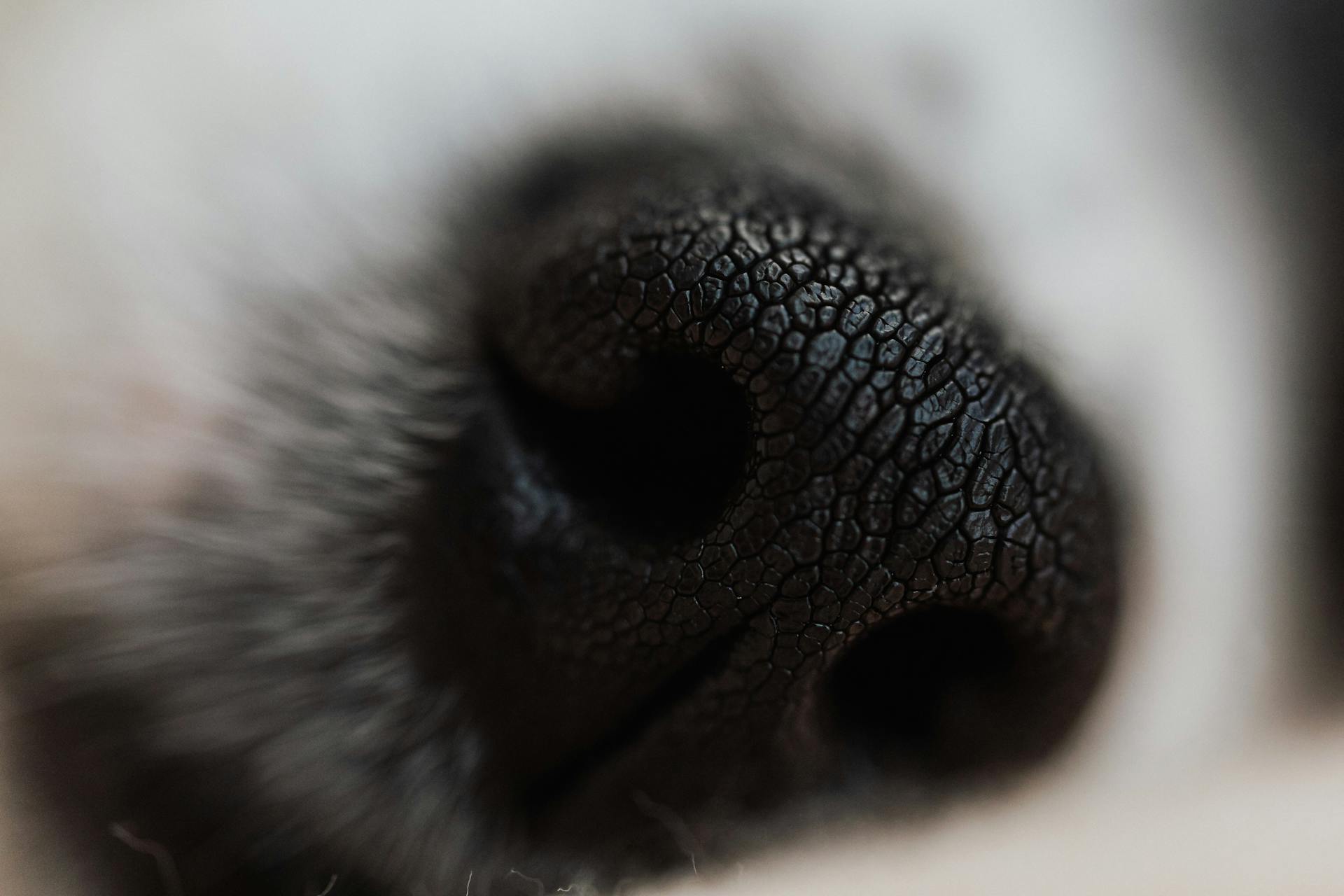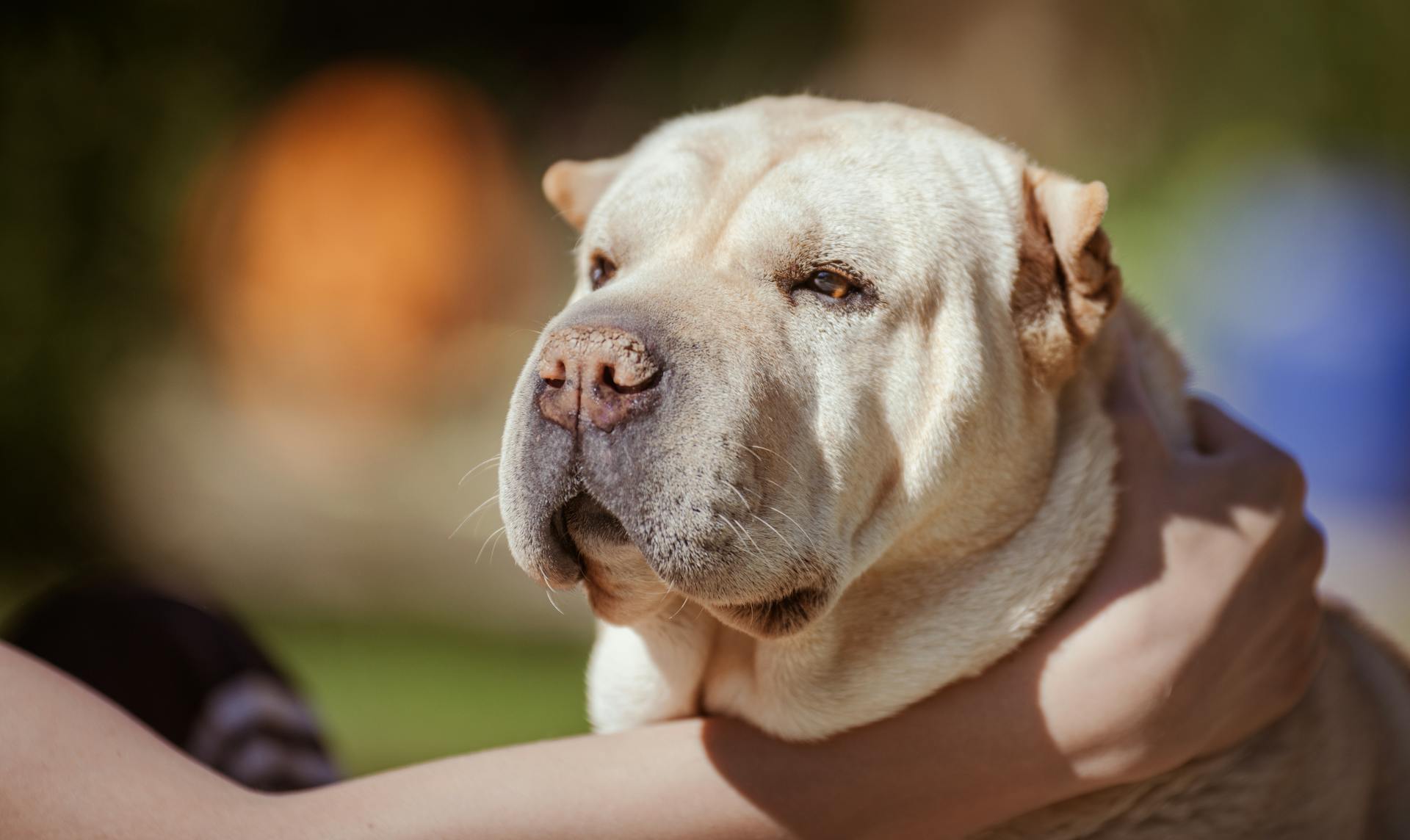
Hypothyroidism in dogs can manifest in various ways, and skin problems are one of the most common symptoms.
Dogs with hypothyroidism often develop skin problems such as hair loss, thinning, and excessive shedding.
These skin issues are usually caused by a decrease in the production of thyroid hormones, which play a crucial role in maintaining healthy skin and coat.
In fact, studies have shown that up to 70% of dogs with hypothyroidism will develop skin problems.
A fresh viewpoint: Can Dogs Develop Allergies Later in Life
Diagnostic Process
Dogs should only be tested for hypothyroidism when the disease is strongly suspected based on their history and physical examination findings.
A stepwise approach is helpful in accurately diagnosing canine hypothyroidism. This means starting with a basic test and moving on to more specific ones if necessary.
Total T4 concentration is a useful screening test for hypothyroidism, with a sensitivity of 89% to 100%. This means it's very effective at detecting the condition.
If the T4 concentration is well within reference range, it's likely the dog is euthyroid and further testing is not required. However, a T4 concentration below reference range is not diagnostic for hypothyroidism on its own.
For another approach, see: Canine Distemper Test
Some medications, such as prednisone, phenobarbital, and trimethoprim-sulfamethoxazole, can lower the serum T4 concentration of dogs. This means test results should be interpreted with caution if the dog is taking these medications.
It's also important to note that nonthyroidal illnesses can alter thyroid hormone metabolism, resulting in the euthyroid sick syndrome. If a dog with a concurrent illness is tested for hypothyroidism, test results should be interpreted with caution.
If a dog's T4 concentration is low, free T4 (fT4) and thyroid-stimulating hormone (TSH) are evaluated next. However, combined T4, fT4, and TSH testing is not recommended unless necessary.
It's best to send samples out to a reference laboratory for testing, as diagnosing hypothyroidism is not an emergency. This will also help ensure accurate results.
Here is a list of medications that can affect T4 concentrations in dogs:
- Prednisone (high dose)
- Phenobarbital
- Trimethoprim–sulfamethoxazole
- Aspirin (high dose)
- Clomipramine
- Thyroxine supplementation
It's also worth noting that "normal" reference ranges for T4 do not apply to sighthounds, as they have lower T4 concentrations than other breeds.
Treatment and Management
Treatment and management of hypothyroidism in dogs is crucial to alleviate skin problems and other symptoms. Treatment typically involves administering levothyroxine, a synthetic version of the thyroid hormone.
Dogs are generally resistant to excessive levothyroxine supplementation, but clinical signs such as polyuria/polydipsia and hyperactivity may develop. Treatment failure is uncommon, but possible reasons include owner noncompliance or variable gastrointestinal absorption of the medication.
The initial dose of levothyroxine is calculated based on the dog's weight, and ongoing adjustments are necessary to regulate each dog's individual response. Repeated thyroid profiles are necessary to ensure the best outcome.
Resolution of clinical signs of hypothyroidism takes a few months, but with regular treatment and monitoring, a dog with hypothyroidism is expected to have a normal, full coat of hair and easily maintain a healthy weight.
You might enjoy: Signs Dog Dying Hemangiosarcoma
Step 1: Evaluate Minimum Results
Before starting treatment, it's essential to evaluate minimum database results for supportive findings. This involves running a complete blood count, serum biochemistry panel, and urinalysis to rule out concurrent disorders that could affect thyroid test results.

Elevated cholesterol levels are a common finding in hypothyroid dogs, with approximately 75% of them showing mild hypercholesterolemia. This can support a suspicion of hypothyroidism, but it's not specific enough to prompt testing on its own.
A mild, nonregenerative anemia is present in about 30% to 40% of hypothyroid dogs, and liver enzymes may be mildly elevated. However, these abnormalities are not specific to hypothyroidism and can be seen in other conditions as well.
A urinalysis typically shows no abnormalities, but dilute urine can indicate a concurrent illness or another cause of clinical signs. It's essential to investigate further in these cases.
Initiating Therapy
Initiating therapy for your furry friend is a crucial step in managing their condition. Most dogs can be regulated with once-daily levothyroxine, usually initiated at 0.02 mg/kg PO q24h.
Starting with a low dose is often the best approach, as it allows your dog's body to adjust to the medication. Lethargy often improves after a few weeks, giving you a good indication that the treatment is working.
Most clinical signs improve within 4 to 6 weeks, but dermatologic changes can take months to resolve. This is why patience and consistent treatment are key to successful management.
Recommended read: Lick Granuloma Treatment Dog
Treatment Failure and Adverse Effects
Treatment failure is uncommon, but it can happen for various reasons.
One possible reason for treatment failure is owner noncompliance in administering medication, which can lead to a lack of T4 concentration in the dog's system.
Variable gastrointestinal absorption of levothyroxine is another possible cause of treatment failure.
If a target post-pill T4 concentration has been achieved and clinical signs are not controlled, the dosing frequency should be increased to twice daily.
Clinical signs such as polyuria/polydipsia and hyperactivity may develop in dogs if they are given excessive levothyroxine supplementation.
Dogs are generally resistant to the effects of excessive levothyroxine supplementation, which is good news for owners who accidentally give their pet too much medication.
Expand your knowledge: Symptoms of Allergies in Dogs
Determining the Proper Dose
The initial dose of thyroid replacement hormone is calculated based on the dog's weight, typically starting at 0.02 mg/kg PO q24h.
This dose may need to be adjusted over time as the dog's tolerance changes. Re-testing thyroid hormone levels every six months is usually necessary to ensure the dog is neither over- nor under-dosed.
A blood sample is taken after one month of treatment to verify that the thyroid hormone levels are normal. The blood sample is usually taken just before or 4-6 hours after medication administration.
Close communication with your veterinarian is essential to ensure the dog is receiving the right dose. Monitoring your dog's condition and reporting any signs of hypothyroidism or hyperthyroidism to your veterinarian is also crucial.
If signs of hypothyroidism recur or if you feel your dog has signs of hyperthyroidism, let your veterinarian know right away.
A different take: Blood Sugar Levels for Dogs with Diabetes
Understanding the Condition
Hypothyroidism is a common condition in dogs that affects their metabolism and can lead to various skin problems. It's usually caused by lymphocytic thyroiditis, an immune-mediated disease, or idiopathic thyroid gland atrophy, where normal thyroid tissue is replaced by fat tissue.
Dogs with hypothyroidism often experience weight gain without an increase in appetite, lethargy, and cold intolerance. They may also have dry, dull hair with excessive shedding, and very thin to nearly bald hair coats.
The condition can be easily treated with daily thyroid supplementation and periodic monitoring, but it's essential to diagnose it early to prevent severe and untreatable neurological disorders. Here are some common signs of hypothyroidism in dogs:
- Weight gain without an increase in appetite
- Lethargy and lack of desire to exercise
- Cold intolerance
- Dry, dull hair with excessive shedding
- Very thin to nearly bald hair coat
What Causes?
Hypothyroidism in dogs is a complex condition with multiple possible causes. The two most common causes account for more than 90% of cases.
Lymphocytic thyroiditis is the most common cause, and it's thought to be an immune-mediated disease. This means the dog's immune system mistakenly attacks the thyroid gland.
Idiopathic thyroid gland atrophy is another common cause, where normal thyroid tissue is replaced by fat tissue. The exact reason for this is unclear.
In both cases, genetics play a role in the development of hypothyroidism. It's a heritable trait, so if your dog has a family history of the condition, they may be more likely to develop it.
Here are the two main causes of hypothyroidism in dogs:
- Lymphocytic thyroiditis: the dog's immune system attacks the thyroid
- Idiopathic atrophy of the thyroid gland: thyroid tissue is replaced by fat, and no apparent cause is identifiable
A Closer Look

Hypothyroidism is a common condition in dogs, affecting middle-aged dogs, typically around 6-7 years old. Many breeds can be affected, although some breeds may be more prone to it.
The condition is caused by reduced production of thyroid hormones by the thyroid glands. In some cases, the cause is lymphocytic thyroiditis, while in others, it remains unknown (idiopathic thyroiditis).
Hypothyroidism can't be cured, but it's easily managed with proper veterinary care. With early diagnosis and treatment, dogs can live a normal life.
Common symptoms of hypothyroidism include unexplained weight gain, lethargy, exercise intolerance, and changes to the skin and coat. Thyroid hormone levels can vary over time and in response to medical conditions.
To diagnose hypothyroidism, low thyroid hormone levels on screening blood tests are often the first indication. Additional blood tests may be needed to confirm the diagnosis.
Hypothyroidism is treatable with daily thyroid supplementation and periodic monitoring. Early detection is key to preventing severe symptoms and ensuring a good prognosis.
Curious to learn more? Check out: Common Dog Diseases and Symptoms

Here are some common signs of hypothyroidism in dogs:
- Weight gain without an increase in appetite
- Lethargy and lack of desire to exercise
- Cold intolerance
- Dry, dull hair with excessive shedding
- Very thin to nearly bald hair coat
- Increased dark pigmentation in the skin
- Increased susceptibility and occurrence of skin and ear infections
- Failure to re-grow hair after clipping or shaving
- High blood cholesterol
- Slow heart rate
Recovery and Next Steps
Recovery from hypothyroidism in dogs requires ongoing adjustments to hormone replacement treatment, as each dog's response is unique and needs to be regulated through repeated thyroid profiles.
The initial dose is calculated based on the animal's weight, but adjustments are necessary to achieve the best outcome.
No notable improvement in symptoms is expected within the first 4 to 8 weeks of treatment.
Resolution of clinical signs takes a few months, but with regular treatment and monitoring, a dog with hypothyroidism can have a normal, full coat of hair and maintain a healthy weight.
Annual routine health screening of adult dogs can aid in early detection, mitigating the development of severe symptoms.
There is no known way to prevent hypothyroidism, which is not contagious.
Frequently Asked Questions
What are the skin signs of hypothyroidism?
Hypothyroidism can cause rough, scaly skin, especially on the hands and feet, due to dryness and thinning of the skin layers. Skin symptoms may resemble other conditions, such as ichthyosis, and require a medical evaluation for proper diagnosis.
What are the dermatological manifestations of hypothyroidism?
Hypothyroidism can cause dry, scaly skin, yellowish discoloration, and changes in nail growth. Skin and nail changes are common dermatological manifestations of this condition.
What does hypothyroid skin look like?
Hypothyroid skin is typically rough, dry, and scaly, with fine scales on the hands, feet, and other areas, often resembling a dry skin condition called ichthyosis. Skin on the palms and soles may be severely dry and cracked.
What are the first signs of hypothyroidism in dogs?
First signs of hypothyroidism in dogs include hair loss on the trunk, back of the rear legs, and tail, as well as a dull, thin coat and flaky skin
Can hypothyroidism cause hyperkeratosis in dogs?
Yes, hypothyroidism can cause hyperkeratosis in dogs, which is a thickening of the skin's outer layer. If left untreated, this condition can lead to further skin problems and other health issues.
Sources
- https://todaysveterinarypractice.com/endocrinology/canine-hypothyroidism-diagnosis-and-treatment/
- https://vetster.com/en/conditions/dog/hypothyroidism-in-dogs
- https://www.petdermatologyclinic.com/hypothyroidism-in-dogs
- https://www.dvm360.com/view/canine-hypothyroidism-fact-or-fiction-proceedings
- https://vcahospitals.com/know-your-pet/hypothyroidism-in-dogs
Featured Images: pexels.com


